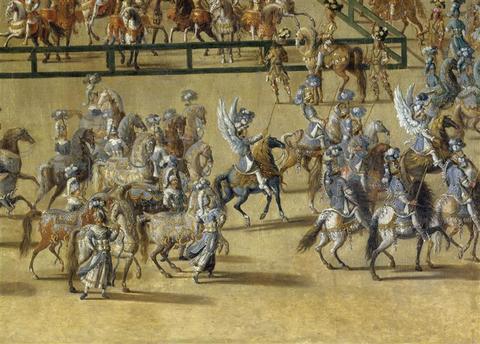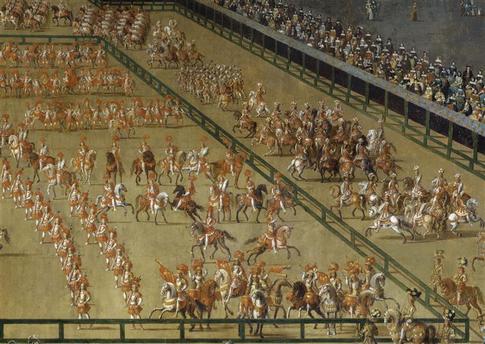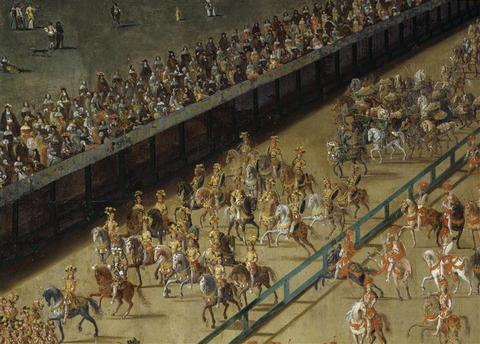The King's mother, Anne of Austria, the Queen Marie Thérèse and the other ladies of the court were placed on dais which had been built especially for the Carousel. It was decorated in purple velvet emblazoned with golden fleur-de-lis. Two other stands had been erected for the princes of the court and the visiting ambassadors. After all, the Carousel was not merely a celebration, it was a display of power.
 |
| Detail |
 |
| Detail |
The Carousel was a display of equestrian spectacle with riders wearing elaborate costumes. On the first day a parade went from the Hôtel de Vendôme to the courtyard of the Tuileries and along the way the people were awed by the 1297 participants of the parade - of which 655 were mounted on horseback.
 |
| Detail |
The theme for this year was a tribute to the most exotic countries at the time - five was chosen - and each was represented by a quadrille. In turn each quadrille was headed by a member of the court and each quadrille had its' own colour scheme.
Louis XIV headed the Romans as their Emperor clad in red and black. The King's own costume was described by an album published on the Carousel in 1669:
"dressed like a Roman in a long coat embroidered with silver and gold ... a silver helmet covered with gold leafs ... from which there rises a plume of ostrich feathers..."Even the King's horse was dressed to impress with a caparison covered in diamonds and red and gold tassels.
 |
| Louis XIV as the Emperor of the Romans |
 |
| Pages following the King |
Monsieur, headed the Persians and wore white and red. Most of his entourage were decked out in elaborate turbans.
 |
| Monsieur |
The Prince de Condé was the figurehead of the Turks in blue and black.
 |
| The Prince de Condé |
 |
| Riders in the quadrille of the Prince de Condé |
The Duc d'Enghien (son of Monsieur) led the Indians in a display of yellow and "flesh colour".
 |
| The Duc d'Enghien |

The Duc de Guise headed the American Indians which were covered in brightly coloured feathers but had otherwise rather simple costumes. The Duc himself wore a silver helmet with a chimera on top.
 |
| The Duc de Guise |
 |
| Musicians in the Duc de Guise's quadrille |
If Voltaire is to be believed then this was the first occasion that Louis XIV wore the sun as his personal emblem.
Different sorts of competitions were planned including one in which the goal was to spear a head (not an actual head, don't worry) of a doll dressed as an Oriental warrior. Also, a ring tilt was prepared where the riders would take turns trying to pass a lance through a hanging ring.
The winners were the Marquis de Bellefonds - who won the head tilt on the first day - and the Comte de Sault, who won the ring tilt on the second day. The Comte de Sault was honoured by being presented with his trophy by Anne of Austria herself. The other winners were granted their prizes by the Queen. One of the prizes given out was an ornate box with a small portrait of the King framed with diamonds.
The five quadrilles would perform mock charges at each other where they fired small, scented balls in bright colours to amuse to spectators. Not only the courtiers were clad in lavish costumes. Their followers wore helmets shaped as dragons, fish and parrots. Others wore long capes in the style of tiger skins or like monkeys.
This was to be Louis XIV's first show of splendour and would also prove to be the only one held in Paris.

Learning about this for my art history class right now, and how later the Arch du Carousel was named this since the carousel took place here. Really interesting stuff! Thanks for posting this!
ReplyDeleteA very nice and informative posting. Thank you!
ReplyDelete